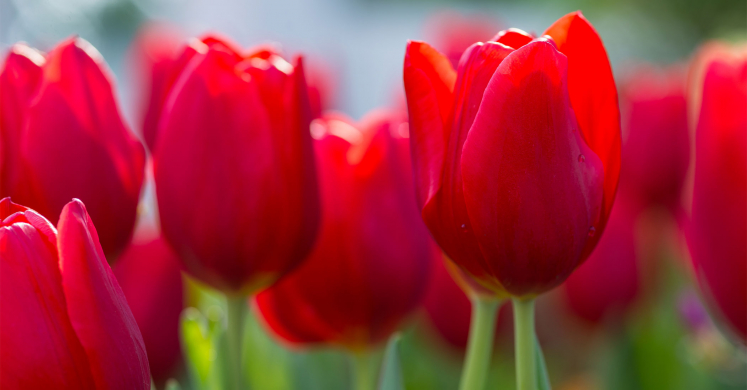Blog

Tulips, a Spring Staple
If you love spring and spring flowers, you’ll love Phipps’ annual Spring Flower Show! One of our fan favorite spring flowers is the tulip; read on to learn more about this elegant and colorful bloom!
Nothing says “welcome” to the first day of spring quite like a tulip, let alone the thousands of them currently on display in Spring Flower Show: Five Senses of Splendor. Today, the tulip is one of the world’s most recognized flowers as well as a widely beloved spring bulb among gardeners. Their varied bright colors and delicately egg-shaped blossoms embody the elements of spring: renewal, regrowth and fresh beginnings. So, dust off the grays of winter with us and use these intriguing facts about tulips to put a spring in your step.
Originally a native wildflower found in central Asia, tulips spread west and were cultivated by the Ottoman Empire where massive beds of tulips began to be introduced to parks and palace gardens. Tulips became so popular within the culture, as well as a symbol of status, that the blooms were beautifully embroidered on fine clothing and noblemen would wear a single tulip in their turbans. There is some speculation that this latter custom lead to the name “tulip,” which is derived from the Persian word delband and means “turban.”
Tulips were first introduced to Europe in the 16th century. Some of these early bulbs and seeds made their way to the French botanist Carolus Clusius, the director of the Leiden botanical garden in Vienna. He cultivated tulips and is credited with starting the tulip craze that suddenly overtook Europe. In fact, tulips became so popular that they were responsible for one of the most infamous financial bubbles of all time; “Tulip-mania,” which occurred in Holland between 1550 and 1637. Bulbs were valued at extreme prices that were so high that a single bulb could be used as a marriage dowry or traded for a business. This bubble burst however in 1637 when doubt crept in that prices would not continue their upward trajectory. This financial crash saw the wealth of speculators disappear almost overnight.
Currently, there are almost 4,000 horticultural varieties of tulips! Solid color tulips are known as “self-colored” whereas streaked flowers are referred to as “broken.” The broken color on the blossoms was initially caused by a virus (harmless to the plant) that allowed the white or yellow hue to peek through the hybridized color. However, the streaked tulips we see today are not the result of a virus but rather of breeding. The solid, sturdy blooms of the Darwin Hybrid may be the iconic bloom we all think of, but tulips come in so many different shapes, sizes and colors. One variety, is having multiple petals, known as “double tulips,” which resembles peonies. Another is "lily tulips” and they have thin pointy petals. “Fringed tulips” do indeed look fringed. No matter what your style or preference, you are sure to find a tulip that suits you.
Tulips are central to our spring show at Phipps! We use thousands of bulbs to add drama and vibrant colors to the beds. However, the tulips we choose for the show are selected for color and design and cannot be counted on to reliably rebloom. If you would like your own tulips in your home garden, try looking for species tulips, also known as wild tulips. These short, rugged flowers not only come back annually but will self-seed and naturalize as well. They bloom in early to mid-spring and make a wonderful flower for boarders that will brighten up your spring garden! Alongside tulips, there are countless flowers that will blossom throughout this season. What’s your favorite spring flower?
Photo © Paul g. Wiegman

